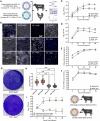This is a preprint.
Primary bovine embryonic fibroblasts support seasonal influenza A virus infection and demonstrate variable fitness of HPAI H5N1
- PMID: 40777344
- PMCID: PMC12330616
- DOI: 10.1101/2025.07.26.666677
Primary bovine embryonic fibroblasts support seasonal influenza A virus infection and demonstrate variable fitness of HPAI H5N1
Abstract
The emergence of highly pathogenic avian influenza (HPAI) H5N1 (clade 2.3.4.4b, genotype B3.13) in dairy cattle presents substantial challenges to the agricultural sector and public health. Mechanistic studies of infection and transmission in cattle have proven difficult due to animal handling restrictions as well as limited availability of established cell culture models. Primary Bovine Embryonic Fibroblasts (BeEFs) were collected from a Montana cow and are investigated here as a model to study influenza A virus (IAV) infection dynamics. We compared sialylation profiles, infectious virus production, viral replication, and plaque morphology in both BeEFs and chicken DF-1 cells following infection with the bovine HPAI H5N1 and an earlier 2.3.4.4b genotype (B1.1) isolated in 2022. The data presented here show increased viral fitness of the bovine origin HPAI H5N1 strains across multiple species and bovine susceptibility to human seasonal IAV. This study highlights the ability of BeEFs to serve as a model for studying IAV infections in bovine hosts.
Conflict of interest statement
Competing Interest Statement: The authors declare no competing interests.
Figures

Similar articles
-
Pathogenicity and transmissibility of bovine-derived HPAI H5N1 B3.13 virus in pigs.Emerg Microbes Infect. 2025 Dec;14(1):2509742. doi: 10.1080/22221751.2025.2509742. Epub 2025 Jun 16. Emerg Microbes Infect. 2025. PMID: 40396285 Free PMC article.
-
H5N1 clade 2.3.4.4b avian influenza viruses replicate in differentiated bovine airway epithelial cells cultured at air-liquid interface.J Gen Virol. 2024 Jun;105(6):002007. doi: 10.1099/jgv.0.002007. J Gen Virol. 2024. PMID: 38922678 Free PMC article.
-
Comparative pathogenicity of three A(H5N1) clade 2.3.4.4b HPAI viruses in blue-winged teal and transmission to domestic poultry.mSphere. 2025 Jun 25;10(6):e0002125. doi: 10.1128/msphere.00021-25. Epub 2025 May 22. mSphere. 2025. PMID: 40401902 Free PMC article.
-
Avian influenza A (H5N1) virus in dairy cattle: origin, evolution, and cross-species transmission.mBio. 2024 Dec 11;15(12):e0254224. doi: 10.1128/mbio.02542-24. Epub 2024 Nov 13. mBio. 2024. PMID: 39535188 Free PMC article. Review.
-
The emergence of highly pathogenic avian influenza H5N1 in dairy cattle: implications for public health, animal health, and pandemic preparedness.Eur J Clin Microbiol Infect Dis. 2025 Aug;44(8):1817-1833. doi: 10.1007/s10096-025-05147-z. Epub 2025 May 14. Eur J Clin Microbiol Infect Dis. 2025. PMID: 40369349 Free PMC article. Review.
References
-
- Nguyen T.-Q., et al. , Emergence and interstate spread of highly pathogenic avian influenza A(H5N1) in dairy cattle in the United States. Science 388, eadq0900 (2025). - PubMed
-
- University of Wyoming Extension, Economic considerations for dairy herds With HPAI. Fence Post (2024).
Publication types
Grants and funding
LinkOut - more resources
Full Text Sources
Miscellaneous
